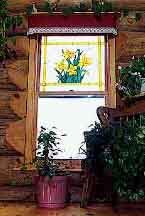Singing the Praises of Logs
The acoustics of a log home
by Roger Ellis, originally published in Log Homes Illustrated, Aug./Sept. 1996
Whenever people talk about what attracts them to a log home, they mention the solid timbers and the craftsmanship. Sure, log homes appeal to the eye. But you also hear praise for their less visible qualities: romance, warmth, comfort, even aroma. A recent experience illustrates another sensory dimension of a log home: acoustics.
It started when my good friend Willie Drennan asked if I would like to get involved in a recording project he was working on. Willie is an Irish-Canadian musician who records, conducts school workshops and performs everywhere from stage to street corner. He is always on the lookout for ways to extend his audience. Nice guy that he is, he usually brings his friends along for the ride.
His latest brainchild was to have a production crew from the Canadian Broadcasting Corp. come to our rural community in Nova Scotia and record a house party for a regional radio show. He invited his musical friends, including the Shoretones, an a cappella quartet I belong to. We gladly accepted. When I asked where this house party was to take place, he said, "Well, how about your house?"
 I live in a log home built over a number of years by myself and my wife
Andrea. The original dwelling was just 24 feet by 28 feet. A few years ago,
we built a 16-by-24-foot addition, which now serves as our living room.
I live in a log home built over a number of years by myself and my wife
Andrea. The original dwelling was just 24 feet by 28 feet. A few years ago,
we built a 16-by-24-foot addition, which now serves as our living room.
Willie, having attended the occasional "do" at our place, knew it to be an acceptable party spot. Around here, party usually means music night. Every second person through the door is packing a guitar, fiddle, flute, harmonica or drum of some sort. Everybody brings their singing voice, and Nat from down the road adds his homemade washtub bass to the mix.
Willie brought CBC producer Jeff Riley and sound technician Rod Sneddon by the house to check it out. After walking around the living room talking, whispering, shouting and listening, they declared it to be an excellent acoustical space. "As good as Studio H," Rod said, referring to CBC's state-of-the-art recording facility in Halifax.
He explained that most homes have gypsum wallboard, which acts as a bass trap. That is, the walls absorb the bass, while the treble bounces around the room, producing a distorted, tinny sound. Our massive logs walls diffuse the sound, retaining all the tones and blending them without echo or distortion. "In fact," Rod noted, "many of the newer recording studios are using a new type of sound-diffuser panel that looks much like your log wall."
When the big day arrived, a huge control room on wheels rolled into our driveway, full of cables, microphones, computers and other equipment. Rod and Jeff got all the gear set up in time for the performers to make their sound checks. Rod had arranged one microphone for each performer, but when the Shoretones did our warm-up, he decided to change things a bit. "The sound in the room is so good that we should take advantage of it," he said, positioning us around one central mike that would not only record the four of us on one channel, but also capture that log-house fullness.
The evening went well. the performers gave it their best, everyone else had fun, and Jeff and Rod were pleased with the results. They admitted they had come to the project with trepidation, having never recorded a house party, but the quality of the talent and the acoustics of the room impressed them.
They're professionals, of course, whose job it is to hear in ways that most of us don't. They can listen to a room and describe in detail all the technical reasons why its acoustics are good or bad. The rest of us hear the same things as they do, but we rarely notice acoustics unless we encounter an exceptional space. Great cathedrals are designed to sound as if the voices and music are soaring up to heaven itself. Purely by accident, cement block stairwells and tiled washrooms are great places to harmonize because they surround singers with their voices.
These examples also point out the acoustics that we wouldn't want in our homes. Echoes and reverberations shouldn't jangle our nerves; a home should accept our voices and instruments and give them back to us undistorted. Think about going into an unfurnished, uncarpeted, drywalled room. It's the kind of place where kids like to yell just to hear their voices bounce off the walls. As a log builder, I've been in many empty log rooms, so I know that log homes don't need to rely on carpets and furniture to make them acoustically pleasing.
Whether we're enjoying our favorite music on the stereo, making our own music with friends or sitting in quiet conversation, we are in a sense listening to the house itself. A log home, with its solid, honest sound, gives us feelings of strength and security that are so hard to describe.
At 1 a.m., Jeff and Rod were all packed up and ready for the two-hour drive back to Halifax. By now the real party was in full swing. Rod paused at the door and gave a last listen to the music flowing from the living room. "You know," he mused, "I think that room is actually better than Studio H."



